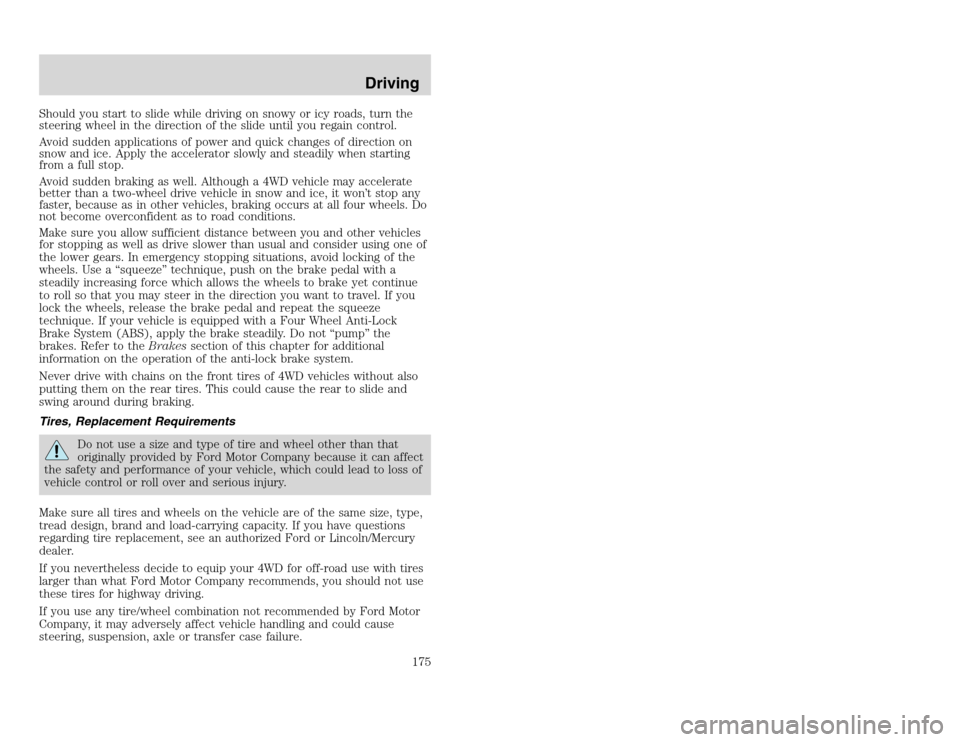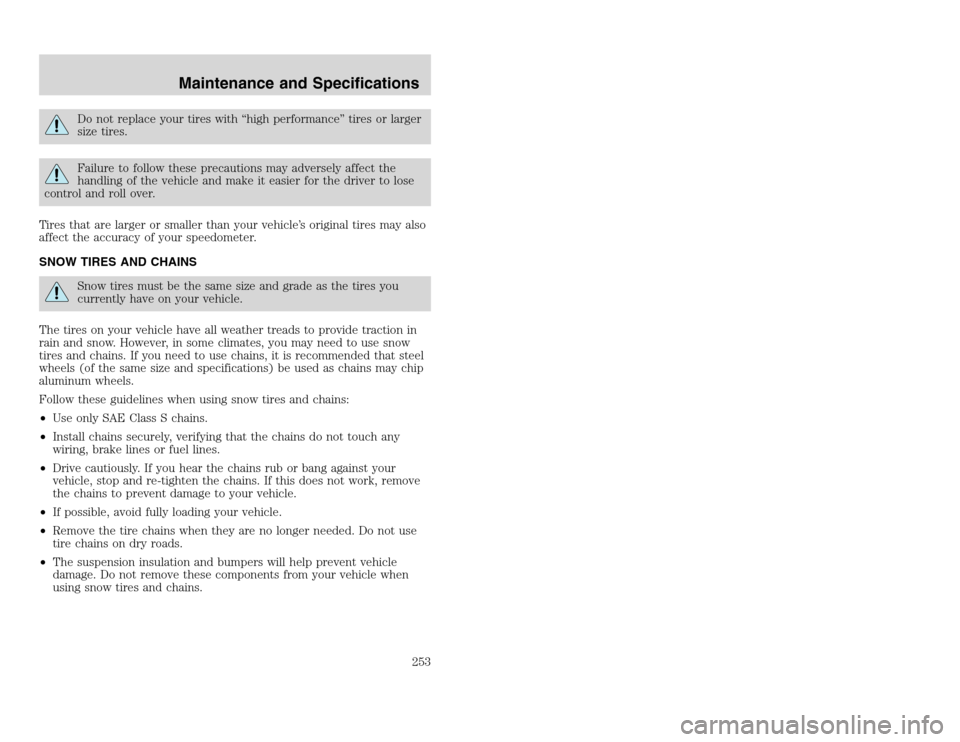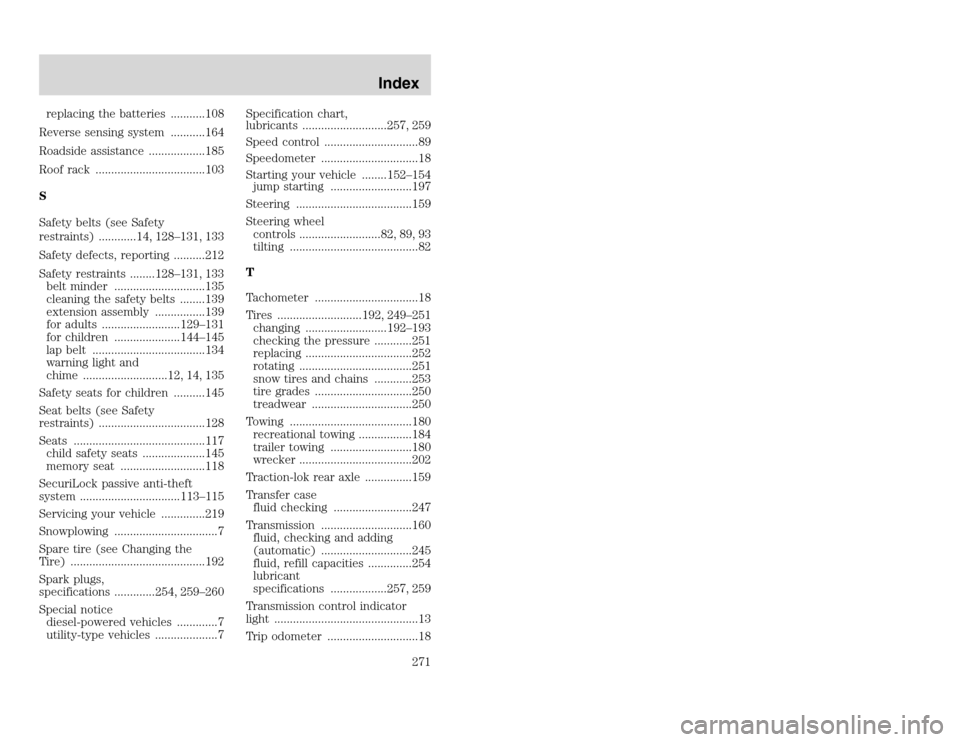snow chains FORD EXCURSION 2002 1.G Owners Manual
[x] Cancel search | Manufacturer: FORD, Model Year: 2002, Model line: EXCURSION, Model: FORD EXCURSION 2002 1.GPages: 272, PDF Size: 5.06 MB
Page 175 of 272

20815.psp Ford O/G 2002 Excursion English 4th Print 2C3J-19A321-HB 04/24/2003 09:14:57 88 A
Should you start to slide while driving on snowy or icy roads, turn the
steering wheel in the direction of the slide until you regain control.
Avoid sudden applications of power and quick changes of direction on
snow and ice. Apply the accelerator slowly and steadily when starting
from a full stop.
Avoid sudden braking as well. Although a 4WD vehicle may accelerate
better than a two-wheel drive vehicle in snow and ice, it won’t stop any
faster, because as in other vehicles, braking occurs at all four wheels. Do
not become overconfident as to road conditions.
Make sure you allow sufficient distance between you and other vehicles
for stopping as well as drive slower than usual and consider using one of
the lower gears. In emergency stopping situations, avoid locking of the
wheels. Use a “squeeze” technique, push on the brake pedal with a
steadily increasing force which allows the wheels to brake yet continue
to roll so that you may steer in the direction you want to travel. If you
lock the wheels, release the brake pedal and repeat the squeeze
technique. If your vehicle is equipped with a Four Wheel Anti-Lock
Brake System (ABS), apply the brake steadily. Do not “pump” the
brakes. Refer to theBrakessection of this chapter for additional
information on the operation of the anti-lock brake system.
Never drive with chains on the front tires of 4WD vehicles without also
putting them on the rear tires. This could cause the rear to slide and
swing around during braking.
Tires, Replacement Requirements
Do not use a size and type of tire and wheel other than that
originally provided by Ford Motor Company because it can affect
the safety and performance of your vehicle, which could lead to loss of
vehicle control or roll over and serious injury.
Make sure all tires and wheels on the vehicle are of the same size, type,
tread design, brand and load-carrying capacity. If you have questions
regarding tire replacement, see an authorized Ford or Lincoln/Mercury
dealer.
If you nevertheless decide to equip your 4WD for off-road use with tires
larger than what Ford Motor Company recommends, you should not use
these tires for highway driving.
If you use any tire/wheel combination not recommended by Ford Motor
Company, it may adversely affect vehicle handling and could cause
steering, suspension, axle or transfer case failure.
Driving
175
Should you start to slide while driving on snowy or icy roads, turn the
steering wheel in the direction of the slide until you regain control.
Avoid sudden applications of power and quick changes of direction on
snow and ice. Apply the accelerator slowly and steadily when starting
from a full stop.
Avoid sudden braking as well. Although a 4WD vehicle may accelerate
better than a two-wheel drive vehicle in snow and ice, it won’t stop any
faster, because as in other vehicles, braking occurs at all four wheels. Do
not become overconfident as to road conditions.
Make sure you allow sufficient distance between you and other vehicles
for stopping as well as drive slower than usual and consider using one of
the lower gears. In emergency stopping situations, avoid locking of the
wheels. Use a “squeeze” technique, push on the brake pedal with a
steadily increasing force which allows the wheels to brake yet continue
to roll so that you may steer in the direction you want to travel. If you
lock the wheels, release the brake pedal and repeat the squeeze
technique. If your vehicle is equipped with a Four Wheel Anti-Lock
Brake System (ABS), apply the brake steadily. Do not “pump” the
brakes. Refer to theBrakessection of this chapter for additional
information on the operation of the anti-lock brake system.
Never drive with chains on the front tires of 4WD vehicles without also
putting them on the rear tires. This could cause the rear to slide and
swing around during braking.
Tires, Replacement Requirements
Do not use a size and type of tire and wheel other than that
originally provided by Ford Motor Company because it can affect
the safety and performance of your vehicle, which could lead to loss of
vehicle control or roll over and serious injury.
Make sure all tires and wheels on the vehicle are of the same size, type,
tread design, brand and load-carrying capacity. If you have questions
regarding tire replacement, see an authorized Ford or Lincoln/Mercury
dealer.
If you nevertheless decide to equip your 4WD for off-road use with tires
larger than what Ford Motor Company recommends, you should not use
these tires for highway driving.
If you use any tire/wheel combination not recommended by Ford Motor
Company, it may adversely affect vehicle handling and could cause
steering, suspension, axle or transfer case failure.
Driving
175
Page 253 of 272

20815.psp Ford O/G 2002 Excursion English 4th Print 2C3J-19A321-HB 04/24/2003 09:14:57 127 A
Do not replace your tires with “high performance” tires or larger
size tires.Failure to follow these precautions may adversely affect the
handling of the vehicle and make it easier for the driver to lose
control and roll over.
Tires that are larger or smaller than your vehicle’s original tires may also
affect the accuracy of your speedometer.
SNOW TIRES AND CHAINSSnow tires must be the same size and grade as the tires you
currently have on your vehicle.
The tires on your vehicle have all weather treads to provide traction in
rain and snow. However, in some climates, you may need to use snow
tires and chains. If you need to use chains, it is recommended that steel
wheels (of the same size and specifications) be used as chains may chip
aluminum wheels.
Follow these guidelines when using snow tires and chains:
•Use only SAE Class S chains.
•Install chains securely, verifying that the chains do not touch any
wiring, brake lines or fuel lines.
•Drive cautiously. If you hear the chains rub or bang against your
vehicle, stop and re-tighten the chains. If this does not work, remove
the chains to prevent damage to your vehicle.
•If possible, avoid fully loading your vehicle.
•Remove the tire chains when they are no longer needed. Do not use
tire chains on dry roads.
•The suspension insulation and bumpers will help prevent vehicle
damage. Do not remove these components from your vehicle when
using snow tires and chains.
Maintenance and Specifications
253
Do not replace your tires with “high performance” tires or larger
size tires.Failure to follow these precautions may adversely affect the
handling of the vehicle and make it easier for the driver to lose
control and roll over.
Tires that are larger or smaller than your vehicle’s original tires may also
affect the accuracy of your speedometer.
SNOW TIRES AND CHAINSSnow tires must be the same size and grade as the tires you
currently have on your vehicle.
The tires on your vehicle have all weather treads to provide traction in
rain and snow. However, in some climates, you may need to use snow
tires and chains. If you need to use chains, it is recommended that steel
wheels (of the same size and specifications) be used as chains may chip
aluminum wheels.
Follow these guidelines when using snow tires and chains:
•Use only SAE Class S chains.
•Install chains securely, verifying that the chains do not touch any
wiring, brake lines or fuel lines.
•Drive cautiously. If you hear the chains rub or bang against your
vehicle, stop and re-tighten the chains. If this does not work, remove
the chains to prevent damage to your vehicle.
•If possible, avoid fully loading your vehicle.
•Remove the tire chains when they are no longer needed. Do not use
tire chains on dry roads.
•The suspension insulation and bumpers will help prevent vehicle
damage. Do not remove these components from your vehicle when
using snow tires and chains.
Maintenance and Specifications
253
Page 271 of 272

20815.psp Ford O/G 2002 Excursion English 4th Print 2C3J-19A321-HB 04/24/2003 09:14:57 136 A
replacing the batteries ...........108
Reverse sensing system ...........164
Roadside assistance ..................185
Roof rack ...................................103
S
Safety belts (see Safety
restraints) ............14, 128–131, 133
Safety defects, reporting ..........212
Safety restraints ........128–131, 133
belt minder .............................135
cleaning the safety belts ........139
extension assembly ................139
for adults .........................129–131
for children .....................144–145
lap belt ....................................134
warning light and
chime ...........................12, 14, 135
Safety seats for children ..........145
Seat belts (see Safety
restraints) ..................................128
Seats ..........................................117
child safety seats ....................145
memory seat ...........................118
SecuriLock passive anti-theft
system ................................113–115
Servicing your vehicle ..............219
Snowplowing .................................7
Spare tire (see Changing the
Tire) ...........................................192
Spark plugs,
specifications .............254, 259–260
Special notice
diesel-powered vehicles .............7
utility-type vehicles ....................7Specification chart,
lubricants ...........................257, 259
Speed control ..............................89
Speedometer ...............................18
Starting your vehicle ........152–154
jump starting ..........................197
Steering .....................................159
Steering wheel
controls ..........................82, 89, 93
tilting .........................................82
T
Tachometer .................................18
Tires ...........................192, 249–251
changing ..........................192–193
checking the pressure ............251
replacing ..................................252
rotating ....................................251
snow tires and chains ............253
tire grades ...............................250
treadwear ................................250
Towing .......................................180
recreational towing .................184
trailer towing ..........................180
wrecker ....................................202
Traction-lok rear axle ...............159
Transfer case
fluid checking .........................247
Transmission .............................160
fluid, checking and adding
(automatic) .............................245
fluid, refill capacities ..............254
lubricant
specifications ..................257, 259
Transmission control indicator
light ..............................................13
Trip odometer .............................18
Index
271
replacing the batteries ...........108
Reverse sensing system ...........164
Roadside assistance ..................185
Roof rack ...................................103
S
Safety belts (see Safety
restraints) ............14, 128–131, 133
Safety defects, reporting ..........212
Safety restraints ........128–131, 133
belt minder .............................135
cleaning the safety belts ........139
extension assembly ................139
for adults .........................129–131
for children .....................144–145
lap belt ....................................134
warning light and
chime ...........................12, 14, 135
Safety seats for children ..........145
Seat belts (see Safety
restraints) ..................................128
Seats ..........................................117
child safety seats ....................145
memory seat ...........................118
SecuriLock passive anti-theft
system ................................113–115
Servicing your vehicle ..............219
Snowplowing .................................7
Spare tire (see Changing the
Tire) ...........................................192
Spark plugs,
specifications .............254, 259–260
Special notice
diesel-powered vehicles .............7
utility-type vehicles ....................7Specification chart,
lubricants ...........................257, 259
Speed control ..............................89
Speedometer ...............................18
Starting your vehicle ........152–154
jump starting ..........................197
Steering .....................................159
Steering wheel
controls ..........................82, 89, 93
tilting .........................................82
T
Tachometer .................................18
Tires ...........................192, 249–251
changing ..........................192–193
checking the pressure ............251
replacing ..................................252
rotating ....................................251
snow tires and chains ............253
tire grades ...............................250
treadwear ................................250
Towing .......................................180
recreational towing .................184
trailer towing ..........................180
wrecker ....................................202
Traction-lok rear axle ...............159
Transfer case
fluid checking .........................247
Transmission .............................160
fluid, checking and adding
(automatic) .............................245
fluid, refill capacities ..............254
lubricant
specifications ..................257, 259
Transmission control indicator
light ..............................................13
Trip odometer .............................18
Index
271